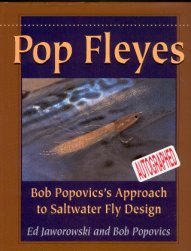Epoxy!  In the latest years this word has become a part of every serious flytyers vocabulary. Its uses in flytying are many, but
mostly it's used for building very durable and very lifelike heads on fish-imitations. One of the most popular and well known
of epoxy-flies is the "Surf Candy", originated by Bob Popovics. If anyone can be credited with the idea of using epoxy as we
do now, it must be Mr. Popovics. Bob Popovics and his partner and friend through the years and well known caster, Ed Jaworowski
has produced this testament of their philosophy on flies and flytying. And it's a good book, there - now I've said it!!!
In the latest years this word has become a part of every serious flytyers vocabulary. Its uses in flytying are many, but
mostly it's used for building very durable and very lifelike heads on fish-imitations. One of the most popular and well known
of epoxy-flies is the "Surf Candy", originated by Bob Popovics. If anyone can be credited with the idea of using epoxy as we
do now, it must be Mr. Popovics. Bob Popovics and his partner and friend through the years and well known caster, Ed Jaworowski
has produced this testament of their philosophy on flies and flytying. And it's a good book, there - now I've said it!!!
Mind you, it's not a beginner's book, basic flytying techniques are not described. The authors only go into detail with specific techniques when absolutely necessary or with techniques specifically needed to use the epoxy the right way.
The preface is written by Lefty Kreh.
The chapters in the book are these: Chapter One, Designing Pop Fleyes; Chapter Two, Materials and Tool; Chapter Three,
Epoxy Pop Fleyes; Chapter Four, Silicone Pop Fleyes; Chapter Five, Additional Pop Fleye Designs.
Chapter One includes a bit of history on the development of the flies. It also includes one of the most interesting paragraphs of
the book, on "Observation on imitation". Jaworowski and Popovics go over, actually quite briefly and yet comprehensively,
what features to look for in the baitfish that are to be imitated. Features like the appearance of the lateral line, the
transparency of the bait, headshape, where the bait's eyes sit, appearance of the bellysac, shine, colour and of course the
overall shape of the bait. They proceed to discuss which of these features are important in tying a good imitation of the bait
in question and they also go over some of the materials they use and their specific attributes in the imitations. All of the above
are condensed into some guidelines for the design of Pop Fleyes. These are 1, Ease of construction; 2, Durability; 3, Castability;
4, Resistance to fouling; 5, Profile/Shape; 6, Incorporation of prominent, identifiable features of the natural, including action;
7, Consideration of where in the water column the fly will be used.
Many different features and characteristics are illustrated with excellent pictures of different baitfish. Not, as they say,
to provide a key to identification of them, but to give examples of how different features that at a quick glance seem alike
really can be.
Chapter Two covers the different materials Ed Jaworowski and Bob Popovics use the most and why they use them and also some
alternatives to their preferred selections. A brief description of the material and its properties and how it's used give a good
overview. Of course tools and chemicals are also covered.
Chapter Three is the first real "tying-chapter" and covers the different epoxy-designs. The Surf Candy is used to describe
and illustrate in detail the tying-sequence for the epoxyflies. Numerous different flies are described and where they differ enough
in tying from the Surf Candy, step-by-step instructions are provided. Most importantly in this chapter is the comprehensive
paragraph on the how's and why's and don'ts of epoxy.
Chapter Four covers the different designs Popovics has created using silicone instead of epoxy for the head-finish.
The primary reason for silicone is less weight on the fly and the ability of the silicone to produce hollow head providing
some buoyancy. Of course there is a similar chapter on the do's, don'ts, how's and why's as in chapter three.
Chapter Five covers the additional designs that fall out of the previous categories. Poppers, blue-water flies,
Deceivers etc.
Throughout the chapters the book is scattered with small insets describing fishing- and casting techniques with the different
flies. These add a good flavour to the book and tell the reader that these flies really have been fished and catch fish.
The overall quality of the photographs is excellent and credit goes to Ed Jaworowski who has taken most of the photos in the book.
They are very important in making the tying-instructions as clear and concise as they are.
Bob Popovics calls his flies "Pop Fleyes". This odd spelling is derived from the first part of mr. Popovics name and included in
the spelling "fleye" is what Jaworowski and Popovics consider perhaps the most important of features, name the eyes of baitfish.
The book is most certainly worth the money and it has provided me with much new inspiration at the vice.
Enjoy!
(Published by Stackpole Books, ISBN 0-8117-1247-8, copyright 2001 by Ed Jaworowski and Bob Popovics).
Review by Lars Chr. Bentsen.
Lars Chr. Bentsen (Viking Lars) (lars@sexyloops.com) is a medieval archeologist
flyfisherman - possibly the first. When not plundering, he either flyfishes the salt "concentrating at all times" or else
investigates ruined castles, abbeys and burial mounds (this is true-life stuff). He is an FFF Certified (or at least certifiable) Master Flycasting Instructor and has a bag fetish. Lars lives with Pauline and their daughters, Anna and Elvira, and they try to live with him.